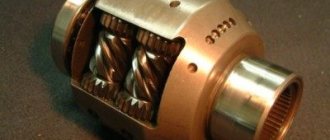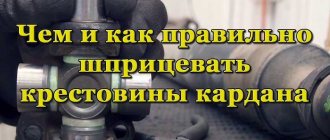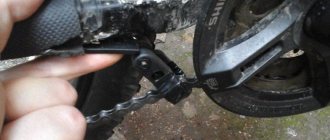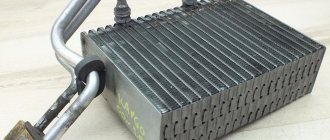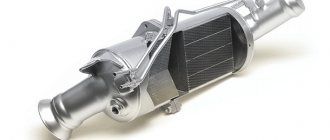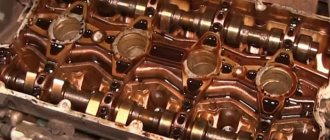A differential in a car is a structure in a car that is part of the transmission. The unit provides the ability to provide different angular velocities for the wheels of the machine. When turning, the wheels on the outside move at their own speed, and the wheels on the inside move at their own speed.
This is natural, because their turning diameter is different. This is easy to see if you draw a diagram of how a car moves around a turn or in a circular motion. The outer wheels always describe a larger circle than the inner ones.
Accordingly, for smooth, comfortable movement, they must rotate differently. This is precisely the purpose of the differential.
How does a differential work?
4x4action.ru
In the language of specialists, the device distributes torque from the driveshaft to the drive wheels. Front or rear - it depends on the type of drive. What is a differential for? “It prevents any wheel from slipping by allowing the wheels to move at different speeds to travel the desired path around a corner.
We can formulate the operating principle of this mechanism:
- Provides transmission of torque from the engine to the wheels.
- Following the gearbox, it reduces the number of revolutions on the way to the wheels, due to which torque increases.
- When transmitting energy movement to the wheels, the mechanism, through a complex gear clutch, creates its own speed on each of them.
https://youtu.be/3mz1BpIE-Ec
avtoexperts.ru
Many buyers, when choosing an SUV, have probably encountered the term “electronic differential lock” in the description of a particular model. But not all potential owners of cars of this class know what it is and how this differential works. In our material today we will tell you in detail why a car needs a differential, what its types are and what cars it is installed on.
Pictured are self-locking differentials
History of creation and purpose of the differential
On cars equipped with an internal combustion engine, the differential appeared a few years after their invention. The fact is that the first copies of cars driven by an engine had very poor handling. When turning, both wheels on the same axis rotated at the same angular speed, which led to slipping of the wheel running along the outer diameter, which was larger than the inner one. The solution to the problem was found simply: the designers of the first cars with internal combustion engines borrowed a differential from steam carriages - a mechanism invented in 1828 by the French engineer Olivier Pecquet-Rom. It was a device consisting of shafts and gears through which torque from the engine is transmitted to the drive wheels. But after installing the differential on the car, another problem was discovered - slipping of the wheel, which had lost traction.
This usually occurred when the vehicle was driving on a road that was covered in patches of ice. Then the wheel that got on the ice began to rotate at a higher speed than the one that was on the ground or concrete, which ultimately led to the car skidding. Then the designers thought about improving the differential so that under such conditions both wheels would rotate at the same speed and the car would not skid. The first person to experiment with creating a limited slip differential was Ferdinand Porsche.
Ferdinand Porsche
It took him three years to develop, test and market the so-called cam differential - the first limited-slip mechanism, which was installed on the first Volkswagen models. Subsequently, engineers developed various types of differentials, which will be discussed below.
In a car, a differential performs three functions: 1) transmits torque from the engine to the drive wheels, 2) sets the wheels at different angular speeds, 3) serves as a reduction gear in combination with the main gear.
Differential device
Improved by automotive designers, the differential is designed in the form of a planetary gear, where torque from the engine is transmitted through a driveshaft and a bevel gear to the differential housing. That, in turn, directs the torque to two gears, and they distribute the torque between the axle shafts. The clutch between the satellite gears and the axle shafts has two degrees of freedom, which allows them to rotate at different angular speeds.
Differential device.
Thus, the differential provides different rotation speeds for wheels located on the same axis, which also prevents slipping when turning. After all-wheel drive was invented, the car had two, and subsequently three (with center) differentials, which distributed torque between the drive axles.
It is already clear that not a single car can do without a differential. In front- and rear-wheel drive vehicles it is located on the drive axle. If a car has a dual drive axle, then two differentials are used in the transmission design - one for each axle. All-wheel drive vehicles have two differentials (for models with plug-in all-wheel drive - one for each axle) or three (for models with permanent all-wheel drive - one for each axle, plus a center differential that distributes torque between the axles). In addition to the number of mechanisms installed on cars with different types of drives, differentials are distinguished by the type of locking.
Types of differentials
According to the type of locking, differentials are divided into two - manual and electronic locking. Manual, as the name suggests, is performed manually by the driver using a button or toggle switch. In this case, the satellite gears of the mechanism are blocked, the drive wheels move at the same speed. Typically, manual differential locking is provided on SUVs.
It is recommended to turn it on when overcoming difficult off-road conditions and turn it off when driving on regular roads.
Electronic or automatic differential locking is carried out using an electronic control unit, which, analyzing the condition of the road surface (information from ABS and traction control system sensors is used), itself blocks the satellite gears.
Range Rover Sport electronically controlled rear differential
According to the degree of locking, this device is divided into a differential with full locking and a differential with partial locking of the satellite gears.
Full differential locking involves a 100% stop of rotation of the satellite gears, at which the mechanism itself begins to perform the function of a conventional clutch, transmitting equal torque to both axle shafts. As a result, both wheels rotate at the same angular speed. If one of the wheels loses traction, all the torque is transferred to the wheel with better traction, which will allow you to overcome off-road conditions. This differential device is used on SUVs Toyota Land Cruiser, Mercedes-Benz G-Class and others.
Full differential lock
Partial differential locking involves incomplete stopping of the rotation of the satellite gears, that is, with slipping. This effect is achieved through so-called self-locking differentials. Depending on how this mechanism works, they are divided into two types: Speed sensitive (function when the angular speeds of rotation of the axle shafts differ) and Torque sensitive (function when the torque on one of the axle shafts decreases). This differential device is used on SUVs Mitsubishi Pajero, Audi with Quattro all-wheel drive system, BMW with X-Drive system and so on.
Differentials belonging to the Speed sensitive group have different designs. There is a mechanism in which a viscous coupling plays the role of a differential. It is a reservoir located between the axle shaft and the rotor of the propeller shaft, filled with a special viscous liquid, into which, in turn, the disks articulated with the axle shaft and the rotor are immersed. When the angular speed of rotation of the wheels differs (one wheel rotates faster than the other), the disks in the tank also begin to rotate at different speeds, but the viscous liquid gradually equalizes their speed, and, accordingly, the torque. As soon as the angular speeds of both wheels are equal, the viscous coupling is turned off. According to its characteristics, a viscous coupling is less reliable than a friction differential, so it is installed on cars designed to overcome moderate off-road conditions or sport modifications of cars.
Another differential mechanism belonging to the Speed sensitive group is the gerotor differential. Here, the role of blocking, in contrast to the viscous coupling, is played by the oil pump and friction plates, which are mounted between the differential housing and the satellite gear of the axle shafts. But the principle of operation is in many ways similar to that of a viscous coupling: when a difference occurs in the angular speeds of the drive wheels, the pump pumps oil onto the friction plates, which under pressure block the differential housing and the axle gear until the rotation speeds of the wheels are equal. As soon as this happens, the pump stops working and the lock is disabled.
Differentials belonging to the Torque sensitive group also have different designs. For example, there is a mechanism that uses a friction differential. Its feature is the difference in the angular speeds of rotation of the wheels when the car is moving on a straight line and in a turn. When driving on a straight road, the angular velocity of both wheels is the same, but when cornering, its value is different for each wheel. This is achieved by installing a friction clutch between the differential housing and the satellite gear, which helps improve the transmission of torque to the wheel that has lost traction.
Another type of differential is with hypoid (worm or screw) and helical gearing. They are conventionally divided into three groups.
The first is with hypoid gearing, in which each axle shaft has its own satellite gears. They are connected to each other using spur gearing, and the gear axis is located perpendicular to the axle axis. When a difference occurs in the angular speeds of the drive wheels, the axle gears become wedged, and friction is formed between the differential housing and the gears. The differential is partially locked and torque is transmitted to the axis whose angular rotation speed is lower. As soon as the angular speeds of the wheels are equalized, the lock is deactivated.
The second is with helical gearing, in which each axle shaft also has its own satellite gears (they are helical), but their axes are located parallel to the axle axes. And these units are combined with each other using helical gearing. The satellites in this mechanism are installed in special niches on the differential housing. When the angular speed of rotation of the wheels differs, the gears wedge, and they, mating with the gears in the niches of the differential housing, partially block it. In this case, the torque is directed to the axle shaft whose rotation speed is lower.
The third is with helical gears of the axle shafts and helical gears of the satellites, which are located parallel to each other. This type is used in the design of the center differential. Thanks to the planetary design of the differential, it is possible, through partial blocking, to shift the torque to the axis whose angular speed of wheel rotation is lower. The range of this shift is very wide - from 65/35 to 35/65. When equal angular speeds of rotation of the wheels of the front and rear axles are established, the differential is unlocked.
These groups of differentials are widely used in the automotive industry: they are installed on both “civilian” and sports models.
What types of differentials are there?
Devices differ according to several criteria
Location
- The interwheel unit is mounted on an axle connecting two wheels.
- The center differential in a car is mounted so that torque is transmitted between the front and rear axles - this is the prerogative of all-wheel drive cars.
Type of gear transmission
- Conical type.
- Cylindrical type.
- Worm type.
Number of gear teeth
- Symmetrical appearance.
- Asymmetrical appearance.
tdiesel.ru
Where are the different types of differentials used?
Devices are installed in accordance with the type of vehicle drive
- A conical symmetrical unit is installed on rear- and front-wheel drive vehicles;
- A cylindrical asymmetric differential is installed on all-wheel drive;
- The worm gear type is acceptable on all types of cars.
A characteristic feature of all-wheel drive vehicles is that they require two differentials between a pair of drive wheels on one axle and one center differential between two axles. But this arrangement is not always structurally provided; there is no device between the bridges.
In this situation, manufacturers recommend that car owners do not engage all-wheel drive on a smooth, level road, but activate it only in off-road conditions.
Types of mechanisms
To get rid of slipping on slippery road surfaces or in off-road conditions, manufacturers equip vehicles with differential devices of the following designs:
- free-type mechanism with forced locking from the drive;
- partially locking limited slip differential;
- self-locking worm gear Torsen type.
In the first option, the gear unit discussed above is used, additionally equipped with a locking device. The system functions simply: if necessary, the driver activates the drive, which locks the satellites in a stationary state. The torque begins to be divided exactly in half, the axles rotate at the same speed and the vehicle successfully overcomes the problem area.
Forced locking of the center differential is activated using various drives:
- mechanical - from the transfer case lever;
- electric;
- pneumatic;
- hydraulic.
Similar drive elements are used to stop and hold the satellites of the front or rear axle.
Manufacturers equip expensive cars with a traction control system. It “deceives” the differential device in another way: based on a signal from a sensor that detects the rapid rotation of one wheel, the electronics gives the command to slow it down. Then the satellite gears begin to transfer more power to the other axle and the car stops “rowing” in place.
High resistance device
In addition to satellites, drive and driven gears, the limited slip differential includes the following elements:
- a housing rigidly attached to the planetary gear;
- a package of friction discs installed on each axle shaft;
- steel disks, whose protrusions are fixed in the body;
- a spacer spring inserted between the bevel gears of the axle shafts.
Steel and friction discs (similar ones are used in clutches) are installed alternately, the first rotate with the body, the second with the axles. The cone-shaped gear is put on the splines of the axle and is capable of moving a certain distance. The spring presses 2 opposite axial gears.
Partial differential locking occurs as follows:
- On a straight, dry section of the road, the satellites are stationary, and the disks rotate relative to each other.
- When one tire hits a slippery area, slippage begins. Thanks to the conical shape of the teeth, the gears on the side of the stopped wheel will begin to repel each other.
- The axle gear will move and compress the disc pack. A friction force will arise, causing the axis to rotate together with the body directly from the planetary gear, bypassing the satellites.
Such a device independently regulates the degree of blocking - the slower a tire with good grip spins, the more the disks are compressed and the more torque is supplied.
Torsen self-locking gears
The operating principle of these mechanisms is based on one feature of the worm pair: the gear is capable of transmitting rotation to the satellite, but the reverse action is impossible. All gears, including satellite ones, are made in the form of cylinders with oblique arcuate teeth. In total, the mechanism uses 3 pairs of worm gears installed around the axle gears.
A limited slip differential works like this:
- During linear motion, worm satellites behave similarly to cone gears - they do not rotate themselves, but rotate the axes from the main gear.
- When turning, the number of revolutions of one axle shaft will increase and it will give rotation to pairs of satellites - the power will begin to be distributed differently.
- Since each pair of satellites is connected to each other by a spur gear, slipping of one wheel is eliminated. The axis is capable of turning its satellite, which rotates the neighboring one, which can no longer turn the second axle axis. The mechanism is locked automatically.
The Torsen device is the most reliable and advanced, but too expensive, so it is installed on top-spec cars. The rest use more accessible high-friction mechanisms.
Among fans of extreme off-road driving, the simplest way to avoid slipping is known - locking the rear differential using welding. The satellites are tightly welded to the axles and are always stationary. True, such cars are intended only for driving on dirt and snow - operating them on hard surfaces is too inconvenient and expensive.
Differential as part of the transmission
studiplom.ru
Since the transmission system of the car is responsible for transmitting torque from the engine to the wheels, the unit is included as an integral part of this system.
Along with it, the standard transmission kit includes:
- Clutch.
- Transmission.
- Wheel drive axle shafts.
- Main gear.
- Angular velocity joints (CV joints).
The unit operates in conjunction with the main gear. An important characteristic of the device is the blocking coefficient - this is the ratio of the torque of one wheel to the other. The higher it is, the higher the vehicle’s cross-country ability can be assessed.
studiplom.ru
| Note! |
The drive type determines where the differential will be located in the vehicle:
|
Safety first
The differential is designed to ensure safe, comfortable maneuvering on the highway. The disadvantages described above apply to driving in extreme conditions, as well as on rough terrain. Therefore, if your vehicle is equipped with a manual locking drive, it should only be used in appropriate road conditions. And highway cars, which are difficult to “persuad” to drive slower than 100 km/h, are generally impossible and even dangerous to operate without a differential. This is a simple, but infinitely important mechanism in the transmission.
Differential device
The assembly contains a set of gears that have 2 degrees of freedom of rotation. The principle of planetary gear operates: within one axis it is possible to add and expand angular velocities.
Structurally, the differential diagram looks like this:
- The main axis leads to the body, transmitting torque from the motor.
- The axle gears on which the wheels are mounted transmit torque.
- Satellites are small gears connected to the body by axles. If necessary, they mesh with the main gears. This ensures the operation of the differential.
salecar.pro
What makes a gearbox special in a car?
Each vehicle gearbox has inherent characteristics, the main one of which is the gear ratio, which reflects the relationship between the angular speed of the drive/driven shafts. A high gear ratio is typical for trucks, a low ratio is typical for cars.
It should be noted that in passenger cars the weight of the gearbox is noticeably lower, due to which they develop high speeds. The gear ratio index is determined by the number of engagements of the driven gear with the drive gear in one revolution. For example, if the index is 4.8, then for a single full revolution of the drive gear, the driven gear engages 4 times and 0.8 times.
Differential operation diagram
The operation of the mechanism can be traced using the example of a symmetrical inter-wheel conical device. It operates on most vehicles on the road: front- or rear-wheel drive.
techautoport.ru
- When a car moves straight, the load between the wheels is uniform, and this also applies to angular speed. The final drive gear transmits torque to the axle shaft through a gear clutch that is stationary.
- Turning leads to uneven distribution of forces on the wheels. The internal one, which needs to travel along a smaller radius, is subject to greater resistance than the external one. He needs to reduce torque and rotation speed. The outer, on the contrary, must move with a higher angular velocity over a larger radius. This is necessary to avoid slipping or drifting, that is, lack of rotation on the wheel. The satellites are driven - gears located at 90 degrees to the main ones; they increase the torque of the outer wheels and, accordingly, their speed.
- Slipping occurs when ice forms in places on the road, or when driving off-road. There is a different load on the wheels - one of them begins to slip. A case similar to a turning situation. The difference is as follows: now the slipping wheel receives increased torque from the differential, and the second one stops moving. Stop - car - the vehicle stops.
To compensate for the problems that arise during slipping conditions, methods have been invented to overcome these troubles.
Differential lock and stability control
Negative aspects of operation can be overcome by blocking or connecting a group of devices that provide directional stability.
Differential lock
Blocking means turning off the satellites.
Different types of vehicles have different locking methods.
Crossovers are equipped with self-locking devices.
For most cars with an electronic control system, electronic locks are connected, combined with a stability control system.
Stability control
cardefence.ru
The electronic active safety system ESC (Electronic Stability Control) is designed to maintain the vehicle's course so that it does not drift when maneuvering. It brakes the car in situations of significant deviation from the trajectory of movement.
Combines the capabilities of ABS - anti-lock braking system and traction control system TCS (Traction Control System), which is designed to prevent slipping of the drive wheels.
Types of differentials
Automotive differentials are divided into several main types:
| Full lock differential | It is turned on by the driver by pressing the corresponding button. Problems: decreased handling and tire wear |
| LSD Limited Slip Differential | Self-locking device: blocking is triggered in a situation where the difference in wheel speeds reaches large values. Thanks to this device, the car smoothly overcomes areas with ice and mud. |
| Thorsen differential. Developed by Co Siemens | Self-locking device option. Differential device: a unit in which the bevel and worm principles are connected. The worm type stops working at a certain torque ratio. |
| Differential Quaife | Design feature: arrangement of satellites parallel to the axis of rotation of the housing |
| Viscous coupling | Self-locking device option. Works like a torque converter. Silicone is poured. At normal t it is in a liquid state. As the temperature increases, it expands and becomes viscous. Disadvantage: such structures are not repairable. |
| Electronic blocker | The block is carried out by the on-board computer under certain conditions that can be set. |
4x4action.ru
Advantages and disadvantages
The main advantage of the differential is that it made it possible to make turns. The speed of movement of each wheel on the drive axle is adjusted to the road situation completely automatically, without driver intervention, so the safety and maneuverability of the vehicle have increased tenfold after the introduction of this mechanism. Today, a differential of one design or another is used in all types of automobile transport.
Another advantage is the fairly high reliability of the node. The planetary gear can withstand heavy loads, and the features of some types of differential further increase its power and wear resistance
The main disadvantage is the need to use a locking mechanism so that the car can move on ice and on difficult roads. Manual, automatic or electronic - any type of locking must be used, which means that there is an additional mechanism that can fail.
And, of course, we must not forget about monitoring the technical condition of the unit. This is another unit in which you need to change the oil, although not often, and monitor the wear of parts. And, by the way, many car owners forget about the need for this procedure.
